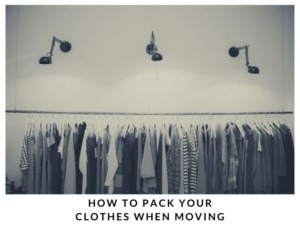 Whether you’re a minimalist when it comes to the clothes you wear or your closet is bursting at the seams, it’s important that you understand how to pack clothing when moving. Granted, your clothes are probably some of the last items you plan to pack, but that doesn’t make them any less important than your furniture and other belongings. Although they aren’t what you would consider as fragile, they can still get dirty, ripped, or torn if they aren’t handled and packed properly. That is why it is important to sort and pack them carefully so that they reach the new destination safely.
Whether you’re a minimalist when it comes to the clothes you wear or your closet is bursting at the seams, it’s important that you understand how to pack clothing when moving. Granted, your clothes are probably some of the last items you plan to pack, but that doesn’t make them any less important than your furniture and other belongings. Although they aren’t what you would consider as fragile, they can still get dirty, ripped, or torn if they aren’t handled and packed properly. That is why it is important to sort and pack them carefully so that they reach the new destination safely.
NYC Movers & Packers has a few helpful tips where packing your clothing for a move is concerned. Keep in mind that unpacking your clothes is also a part of the moving process once you’re getting settled in your new place. So it’s important that you have a plan in place on both ends of your move. You’ll find things will progress a lot smoother if you do. Here a few helpful suggestions on how to pack clothing when moving while being more efficient at the same time.
How do you prepare to pack your clothing?
Two of the most essential factors of the moving process are planning and preparation. This is especially true when it comes to packing your personal belongings including your clothes. Thus, before you start grabbing your clothes and rushing through the packing process, you’ll need to determine what’s moving with you and what’s not. Ask yourself the following questions:
- Do I still love this piece of clothing and does it still look good on me?
- Does the item show sign of excessive wear and tear?
- Does the item still fit? (This question is especially important where your children’s clothes are concerned.)
- Is this piece of clothing outdated or still appropriate?
Remember, the more clothing you can get rid of now, the easier it will be to put away the items you move with you. Don’t let sentimentality cloud your judgment. It could cost you additional money, space, and time. You have a few choices where your discarded clothing items are concerned. You can donate it to a charity or thrift store, have a moving sale and sell it, or use it for additional protection when packing fragile items.
What preparation is required before packing your clothing?
Just as planning is an essential component of the moving process, so is preparing for moving day. This is especially true when it comes to the clothing items you’ve decided to take with you. If you understand how to pack clothing when moving, things will be less stressful later on. If time permits, NYC Movers & Packers recommends washing your clothes before packing them.
The next step is the order in which you pack your clothing. Start by packing you least used items first unless you think there’s a possibility you will need them prior to moving day. For instance, pack dressy or formal attire and clothing that’s non-seasonal. In other words, if you’re moving in summer, pack your winter items such as heavy jackets, scarves, etc.
How do you sort your clothing before packing it?
Most people are unaware that there is a system for how to pack clothing when moving. So, the next step is to sort your clothing by material, season, and type and then pack them accordingly as follows:
- Material – items such as cashmere cardigans and wool sweaters should be packed together. This is especially helpful for clothing that is getting stored. Putting in moth balls helps if you don’t intend opening it anytime soon.
- Season – sort your clothing based on each season starting with the season that is the farthest away. Thus, if it’s spring, start by packing your winter clothing.
- Type – you wouldn’t pack a pair of cargo shorts in the same manner as a sundress, would you? That’s reason enough to pack clothing by type. It is essential that you start a few weeks early and sort through the clothing so that it is easy to pack later on.
Furthermore, hanging clothing is packed separately from that which isn’t hanging. For instance, hanging clothing can be packed in garment bags, on portable hanging racks, or in wardrobe boxes. On the other hand, your non-hanging items are probably folded and being stored in a chest of drawers or dresser. The best way to pack these items is to leave them where they are. Finally, pack shoes heel-to-toe or sole-to-sole, putting the heaviest pairs on the bottom and lighter pairs on top.




